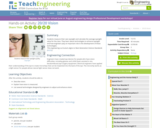
very useful to understand liquid
- Subject:
- Applied Science
- Material Type:
- Reading
- Author:
- Kevin Maximo
- Matheo Ryan
- May Ann Antiquisa
- Date Added:
- 03/26/2020

very useful to understand liquid

In this activity, students determine their own eyesight and calculate what a good average eyesight value for the class would be. Students learn about technologies to enhance eyesight and how engineers play an important role in the development of these technologies.

Find mini lessons and anchor charts for each grade level (K-2, 3-6, 7-9 & 10-12) on The Writing Revolution's sentence-level activities, note-taking strategies, a sequence for teaching a single paragraph and multiple paragraph compositions with activities and examples. An implementation plan is provided, as well as how to infuse writing into math, along with pacing guides and other lesson ideas. This resource has everything you need to start using The Writing Revolution at the sentence-level, note-taking, paragraph and mutiple paragraph writing strategies in your classroom or school. We recommend that you have a copy of this book to use as a support in your classroom to assist with implementaiton (especially if you are the ELA teacher). This is an outstanding resource.

This eBook was written as the sequel to the eBook titled DC Circuits, which was written in 2016 by Chad Davis.
This eBook covers Alternating Current (AC) circuit theory as well us a brief introduction of electronics. It is
broken up into seven modules. Module 1 covers the basic theory of AC signals. Since only DC sources are used in
the first eBook, details of AC signals such as sinusoidal waveforms (or sine waves), square waves, and triangle
waves are provided. Module 2, titled AC Circuits Math Background, covers the mathematics background needed
for solving AC circuit problems. The background material in Modules 1 and 2 are combined in Module 3 to solve
circuits with AC sources that include resistors, inductors, and capacitors (RLC circuits).

An essential and practical text for both students and teachers of AC electrical circuit analysis, this text picks up where the companion DC electric circuit analysis text leaves off. Beginning with basic sinusoidal functions, ten chapters cover topics including series, parallel, and series-parallel RLC circuits. Numerous theorems and analysis techniques are examined including superposition, Thévenin's theorem, nodal and mesh analysis, maximum power transfer and more. Other important topics include AC power, resonance, Bode plots and an introduction to three-phase systems. Each chapter begins with a set of chapter objectives and includes a summary and review questions. A total of over 500 end-of-chapter exercises are included. A companion laboratory manual is available.

Student groups create working radios by soldering circuit components supplied from AM radio kits. By carrying out this activity in conjunction with its associated lesson concerning circuits and how AM radios work, students are able to identify each circuit component they are soldering, as well as how their placement causes the radio to work. Besides reinforcing lesson concepts, students also learn how to solder, which is an activity that many engineers perform regularly giving students a chance to be able to engage in a real-life engineering activity.

Students conduct a simple experiment to model and explore the harmful effects of acid rain (vinegar) on living (green leaf and eggshell) and non-living (paper clip) objects.

Students construct rockets from balloons propelled along a guide string. They use this model to learn about Newton's three laws of motion, examining the effect of different forces on the motion of the rocket.

Aerospace Structures by Eric Raymond Johnson is a 600+ page text and reference book for junior, senior, and graduate-level aerospace engineering students. The text begins with a discussion of the aerodynamic and inertia loads acting on aircraft in symmetric flight and presents a linear theory for the status and dynamic response of thin-walled straight bars with closed and open cross-sections. Isotropic and fiber-reinforced polymer (FRP) composite materials including temperature effects are modeled with Hooke’s law. Methods of analyses are by differential equations, Castigliano’s theorems, the direct stiffness method, the finite element method, and Lagrange’s equations. There are numerous examples for the response axial bars, beams, coplanar trusses, coplanar frames, and coplanar curved bars. Failure initiation by the von Mises yield criterion, buckling, wing divergence, fracture, and by Puck’s criterion for FRP composites are presented in the examples.
Resources
PDFs (book and chapter-level)
Problem sets: http://hdl.handle.net/10919/104169
LaTeX sourcefiles: Expected spring 2022
Print (Softcover. Does not include appendix): https://www.amazon.com/dp/1949373444.
Professors, if you are reviewing this book for adoption in your course, please let us know here: http://bit.ly/interest-aerospace-structures. Instructors reviewing, adopting, or adapting parts or the whole of the text are especially encouraged to sign up.

Students are introduced to air masses, with an emphasis on the differences between and characteristics of high- versus low-pressure air systems. Students also hear about weather forecasting instrumentation and how engineers work to improve these instruments for atmospheric measurements on Earth and in space.

The Airplane Flying Handbook provides basic knowledge that is essential for pilots. This handbook introduces basic pilot skills and knowledge that are essential for piloting airplanes. It provides information on transition to other airplanes and the operation of various airplane systems. It is developed by the Flight Standards Service, Airman Testing Standards Branch, in cooperation with various aviation educators and industry. This handbook is developed to assist student pilots learning to fly airplanes. It is also beneficial to pilots who wish to improve their flying proficiency and aeronautical knowledge, those pilots preparing for additional certificates or ratings, and flight instructors engaged in the instruction of both student and certificated pilots. It introduces the future pilot to the realm of flight and provides information and guidance in the performance of procedures and maneuvers required for pilot certification.

"Comment ajuster la position de début et de fin d'un servomoteur à l'intérieur d'une chaussette servo."

Open Stax
Short Description:
Welcome to Microbiology, an OpenStax resource. This textbook was written to increase student access to high-quality learning materials, maintaining highest standards of academic rigor at little to no cost. Data dashboard
Long Description:
Download for free at https://open.oregonstate.education/microbiology
Publication and on-going maintenance of this textbook is possible due to grant support from Oregon State University Ecampus.
Suggest a correction
Word Count: 147866
(Note: This resource's metadata has been created automatically by reformatting and/or combining the information that the author initially provided as part of a bulk import process.)

Students learn how nanoparticles can be creatively used for medical diagnostic purposes. They learn about buckminsterfullerenes, more commonly known as buckyballs, and about the potential for these complex carbon molecules to deliver drugs and other treatments into the human body. They brainstorm methods to track buckyballs in the body, then build a buckyball from pipe cleaners with a fluorescent tag to model how nanoparticles might be labeled and detected for use in a living organism. As an extension, students research and select appropriate radioisotopes for different medical applications.

The lesson begins with a demonstration introducing students to the force between two current carrying loops, comparing the attraction and repulsion between the loops to that between two magnets. After formal lecture on Ampere's law, students begin to use the concepts to calculate the magnetic field around a loop. This is applied to determine the magnetic field of a toroid, imagining a toroid as a looped solenoid.

Students analyze the relationship between wheel radius, linear velocity and angular velocity by using LEGO(TM) MINDSTORMS(TM) NXT robots. Given various robots with different wheel sizes and fixed motor speeds, they predict which has the fastest linear velocity. Then student teams collect and graph data to analyze the relationships between wheel size and linear velocity and find the angular velocity of the robot given its motor speed. Students explore other ways to increase linear velocity by changing motor speeds, and discuss and evaluate the optimal wheel size and desired linear velocities on vehicles.

This book is designed for use in an introductory course on digital logic design, typically offered in computer engineering, electrical engineering, computer science, and other related programs. Such a course is usually offered at the sophomore level. This book makes extensive use of animation to illustrate the flow of data within a digital system and to step through some of the procedures used to design and optimize digital circuits.

El actual crecimiento de las comunicaciones inalámbricas, debido al incremento de las comunicaciones de voz, vídeo y consumo de datos está causando una creciente demanda de la cantidad de canales y el ancho de banda, esto, está impulsando a los sistemas transceptores de comunicación hacia frecuencias de microondas y de ondas milimétricas para satisfacer la demanda mundial de mayores velocidades de transmisión de banda ancha, los sistemas de comunicación de comunicación inalámbrica requiere también de n desarrollo a la par de esta demanda. La Teoría electromagnética proporciona la base para todos los circuitos de microondas que hizo posible los grandes avances logrados por el campo de microondas. Es importante entender que la teoría de campo de microondas es sólo una parte de la teoría del campo electromagnético en general.

Short Description:
This lab manual provides students with the theory, practical applications, objectives, and laboratory procedure of ten experiments. The manual also includes educational videos showing how student should run each experiment and a workbook for organizing data collected in the lab and preparing result tables and charts.
Long Description:
Basic engineering knowledge about fluid mechanics is required in various sectors of water resources engineering, such as designing hydraulic structure on any riverine environments and flood mitigation process. The objective of this book is to enable students to understand fundamental concepts in the field of fluid mechanics and apply those concepts in practice. Applied Fluid Mechanics Lab Manual is designed to enhance civil engineering students’ understanding and knowledge of experimental methods and basic principles of fluid mechanics. The ten experiments in this lab manual provide an overview of widely used terms and phenomena of fluid mechanics and open channel flow, which are required for solving engineering problems.
Word Count: 21988
ISBN: 978-1-64816-997-7
(Note: This resource's metadata has been created automatically by reformatting and/or combining the information that the author initially provided as part of a bulk import process.)

Este libro está dirigido, principalmente, a Estudiantes y Docentes que quieren aprender a programar como forma de fortalecer sus capacidades cognoscitivas y así obtener un beneficio adicional de su computador para lograr un mejor provecho de sus estudios. Dada la orientación del libro respecto a programar para resolver problemas asociados a las Ciencias e Ingenierías, el requisito mínimo de matemáticas que hemos elegido para presentar el contenido del mismo se cubre, normalmente, en el tercer año del bachillerato. No obstante, el requisito no es obligatorio para leer el libro en su totalidad y adquirir los conocimientos de programación obviando el contenido matemático.